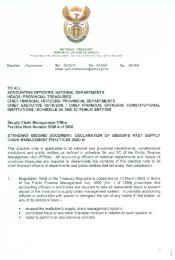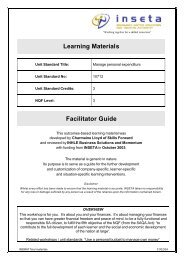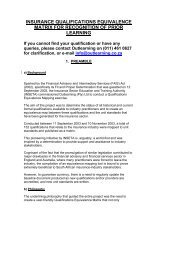SSP Brochure:Layout 1 - INSETA
SSP Brochure:Layout 1 - INSETA
SSP Brochure:Layout 1 - INSETA
Create successful ePaper yourself
Turn your PDF publications into a flip-book with our unique Google optimized e-Paper software.
2.3 Employment trends2.3.1 Changes in total employmentIn the survey of employment, critical and scarce skills, organisations had to indicate changes (percentage increases or decreases) in theirestablishments since 2003. It duly emerged that 13% of the organisations in the sector had grown in terms of the number of employeessince 2003, 70% had stayed the same and 11% had become smaller (6% did not respond to the question).The percentage changes indicated by the individual organisations were then used in combination with their current employment figures todetermine employment growth in the sector from 2003 to 2005. The results of these calculations indicate that the total number of peopleemployed in the insurance sector increased by approximately 1.9% a year from 98 600 employees in 2003 to 102 400 employees in 2005.Growth in business and an increase in product and service ranges were the main contributors to growth in employment. Internalorganisational restructuring to achieve greater efficiency, business problems and external restructuring through, for example, mergers oracquisitions were the main reasons why some organisations experienced decreases in employment over the two-year period.2.3.2 Changes in the occupational structure of the industryThere is no historical information available on the occupational structure of the insurance sector that would allow the analysis of changesin this structure over time. In Chapter 1 various factors that could impact on the occupational structure have been mentioned. If specificoccupations in the industry are considered, occupational changes are generally following international trends in the insurance sector. Asinsurance companies begin to offer more information and services on the internet, some occupations, such as insurance sales agents,experience slower employment growth. The use of underwriting software that automatically analyses and rates insurance applicationslimits the employment growth of underwriters. Also, computers linked directly to the databases of insurance carriers and other organisationshave made communications easier among sales agents, adjusters, and insurance carriers, so that all have become much more productive.Efforts to contain costs have also led to an increasing reliance on customer service representatives to deal with the day-to-day processingof policies and claims. In addition, the internet has made insurance investigators more productive by drastically reducing the amount of timeit takes to perform background checks, allowing investigators to handle an increasing number of cases, but limiting their employmentgrowth. 43The utilisation of call centres for marketing and selling of insurance products as well as the provision of information services and claimshandling has increased substantially over the last number of years. Call centre operators may be viewed as a relatively new and growingoccupational group. Within this group there are “specialisations” i.e. call centre operators are not only trained in call centre operations, butalso in the functioning of the component of the industry, as well as in the products, systems and policies of the companies for which theywork.Survey results show that only 23% of employers thought that some occupations in their organisations would increase or decrease morethan other occupations in terms of the number of people employed. Most employment changes would take place in the professional andadministrative occupational categories. Among professionals, employers expected that more insurance brokers and underwriters wouldbe appointed in future mainly because of expected growth in business. Growth in the number of general and industry-specific clerks andinsurance administrators was foreseen for the same reason.Apart from employment growth in specific occupations, employers had to indicate if occupations that had not existed in the organisationpreviously were growing because of, for example, technological changes. Only 5% of the organisations in the sector reported newoccupations in their occupational structure. However, none of these occupations was really new to the sector – they merely representedexpansions of the organisations themselves and the incorporation of new functions that already existed in the sector.2.3.3 Changes in skills levels requiredThe insurance sector is looking increasingly towards higher qualified and skilled employees. The concept of continuous professional education(CPE) for key employees is seen as a business imperative because of the continually changing operating environment and the need to keepabreast of local and global developments.The reinsurance and asset management subsectors indicated that in future they would be looking at recruiting only graduates for themajority of occupational categories in their organisations. In fact, in some companies, existing employees without at least an NQF 7qualification are encouraged to obtain a relevant qualification within a specified timeframe. The minimum requirement is a degree inaddition to the in-house training provided to employees. 44The educational levels of intermediaries are now determined by the FAIS regulations. Currently, they are required to obtain only a minimumof 60 credits at NQF level 5. In future, this may well be increased to a full qualification at level 5. 45Overall, the industry has been undergoing a professionalisation process that is increasing the demand for higher levels of skills. This need43 USA Bureau for Labor Statistics, http://www.bls.gov/oco/cg/cgs028.htm.44 Information provided during the 2004 interviews with the CEOs.45 Opinion expressed by professional bodies who participated in the <strong>SSP</strong> development process in 2005.<strong>INSETA</strong> Sector Skills Plan - page 17
















